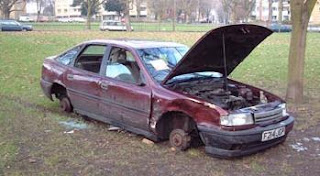Would Crushing Old Cars Improve the Environment?
By Chris Haak
07.22.2008
 One way in which several state and provincial governments have attempted to improve air quality over the years has been to pass “clunker laws.” They are all different, but most have the same fundamental design: the government pays a bounty to individuals who “turn in” an old, theoretically polluting, car, and that car is then disabled so that it can no longer be driven. Sometimes, the turned in car is actually crushed and recycled.
One way in which several state and provincial governments have attempted to improve air quality over the years has been to pass “clunker laws.” They are all different, but most have the same fundamental design: the government pays a bounty to individuals who “turn in” an old, theoretically polluting, car, and that car is then disabled so that it can no longer be driven. Sometimes, the turned in car is actually crushed and recycled.
As a fan of both classic cars and of a clean environment, I find myself somewhat torn by initiatives to remove old vehicles from our roadways. However, it’s hard to argue with the fact that a modern vehicle is not only something like 100 times less polluting, generally more fuel efficient, as well as being safer for its driver and passengers than a 20 year old vehicle.
For a while, I have questioned why it’s necessary to continually make already-clean new vehicles even cleaner in subsequent model years. After all, the exhaust emissions from ULEV vehicles is pretty darn clean. So if a PZEV is even cleaner, does that make it worthwhile to have PZEVs, or would regulatory energies be better focused on removing the worst polluters from our roadways instead? The absolute air quality improvement from a ULEV to a PZEV is nothing compared to the difference between a 1985 Chevy Celebrity with a piston ring leak and defective catalytic converter, and a 2001 Chevy Malibu with its emission equipment in good working order.
A frequently-quoted statistic says that 10% of our auto fleet produces 90% of our auto-related pollution. I have no idea if that is true, but if it is, finding a way to clean up those worst offenders seems to be the shortest route to cleaning up our auto fleet.
California has a program that costs $50 million per year to clean up or “retire” vehicles that fail emission tests. The program provides $500 to repair or $1,500 to retire vehicles that fail emission tests. Last year, the program retired 16,000 cars, which works out to a puzzling $3,125 per vehicle average, or more than twice the maximum allowance of $1,500. Government “efficiency,” perhaps?
In Texas, a vehicle that fails an emission test and can be driven to the dealership under its own power is eligible for a $3,000 voucher to buy a car up to three years old (or a truck up to two years old). Buying a hybrid up to one year old gets the buyer a $3,500 voucher. Participants in the program must have a family income of $63,000 or less for a family of four to be eligible. $3,000 off a cleaner car isn’t bad; a three year old 2005 Cavalier can be had for as little as $6,000 to $6,500. Financing the remaining $3,000 to $3,500 gets a monthly payment of under $100 when financed over 36 months.
The biggest problem that many automotive enthusiasts have with so-called “clunker laws” is that crushing (euphemistically referred to as “retiring” in many programs) cars limits the availability of spare parts to keep nicer, roadworthy versions of the same vehicle humming along in tip-top shape. Just as cars of the 1950s and 60s were the “classics” as I was growing up in the 1980s, for better or worse, our automotive history will be incomplete without a few examples of 1980s Oldsmobile diesels, Ford Tauruses, Chrysler minivans and K-cars, and the aforementioned 1985 Celebrities. And they may not seem like “classics” now, but preservation of at least some examples of nearly every vehicle is essential for sharing our automotive history with future generations. After all, how will I be able to properly tell my sons about my 1987 Grand Am without showing them one in the flesh?
Perhaps the best compromise, although still less than perfect, would be to remove the polluters from the road with a nice incentive to purchase a newer, cleaner vehicle, then crushing only the absolute worst examples and parting out the salvageable ones.
My father, who has done more than 20 frame-off restorations, including several AACA Senior and Grand National winners, used to say that modern cars just wouldn’t be around to restore in 25 years. I’m beginning to wonder if he was right, although I hope that in ten years, I’ll be able to take my sons to Carlisle to show them what a “performance car” looked like in the 1980s. (Answer: Not much.)
COPYRIGHT Full Metal Autos – All Rights Reserved


